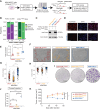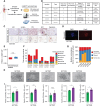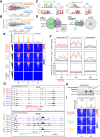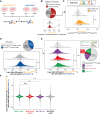Gain-of-Function Chromatin Remodeling Activity of Oncogenic FOXL2C134W Reprograms Glucocorticoid Receptor Occupancy to Drive Granulosa Cell Tumors
- PMID: 39652611
- PMCID: PMC11873728
- DOI: 10.1158/0008-5472.CAN-24-2341
Gain-of-Function Chromatin Remodeling Activity of Oncogenic FOXL2C134W Reprograms Glucocorticoid Receptor Occupancy to Drive Granulosa Cell Tumors
Abstract
Adult type ovarian granulosa cell tumors (AGCT) are rare malignancies with the near universal c.C402G (p.Cys134Trp) somatic mutation in FOXL2, a forkhead box family transcription factor important for ovarian function. Relapsed AGCT is incurable, but the mechanism of the unique FOXL2 mutation could confer therapeutic vulnerabilities. To identify FOXL2C134W-dependent pharmacologic synergies, we created and characterized endogenous FOXL2 isogenic AGCT cells and an AGCT tumoroid biobank. A drug screen identified that glucocorticoids promote FOXL2C134W-dependent AGCT growth. Epigenetic investigation revealed that the Cys134Trp mutation exposes latent DNA sequence-specific chromatin remodeling activity in FOXL2. FOXL2C134W-dependent chromatin remodeling activity redirected glucocorticoid receptor chromatin occupancy to drive hyaluronan synthase 2 gene expression and increase extracellular hyaluronan secretion. Treatment of AGCT models with hyaluronidase reduced viability, and dexamethasone rescued this effect. Combinatorial drug-drug interaction experiments demonstrated that dexamethasone antagonizes the potency of paclitaxel, a chemotherapy agent frequently used in the treatment of AGCT. Thus, gain-of-function pioneering activity contributes to the oncogenic mechanism of FOXL2C134W and creates a potentially targetable synergy with glucocorticoid signaling. Significance: Glucocorticoids promote granulosa cell tumor growth via epigenetic coregulation with the disease driver FOXL2C134W, providing mechanistic insight into disease oncogenesis and uncovering a potential treatment strategy.
©2024 The Authors; Published by the American Association for Cancer Research.
Conflict of interest statement
A.K. Sood reports personal fees from Merck, GSK, Onxeo, ImmunoGen, Iylon, and AstraZeneca and other support from Advenchen outside the submitted work. D.M. Gershenson reports personal fees from Verastem Oncology, Elsevier, and UpToDate, and other support from Bristol Myers Squibb, Johnson & Johnson, and Procter and Gamble outside the submitted work. R.T. Hillman reports grants from Sumitomo Pharma outside the submitted work. No disclosures were reported by the other authors.
Figures








References
-
- Ferlay J, Soerjomataram I, Dikshit R, Eser S, Mathers C, Rebelo M, et al. . Cancer incidence and mortality worldwide: sources, methods and major patterns in GLOBOCAN 2012. Int J Cancer 2015;136:E359–86. - PubMed
-
- Savage P, Constenla D, Fisher C, Shepherd JH, Barton DP, Blake P, et al. . Granulosa cell tumours of the ovary: demographics, survival and the management of advanced disease. Clin Oncol 1998;10:242–5. - PubMed
MeSH terms
Substances
Supplementary concepts
Grants and funding
LinkOut - more resources
Full Text Sources
Medical
Research Materials

